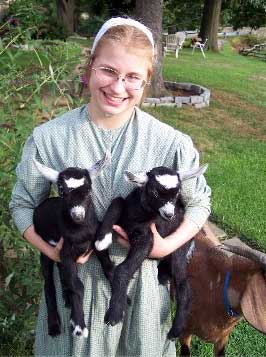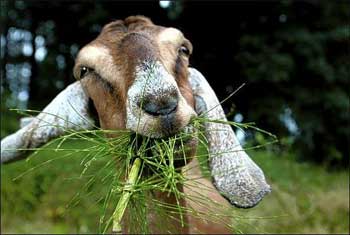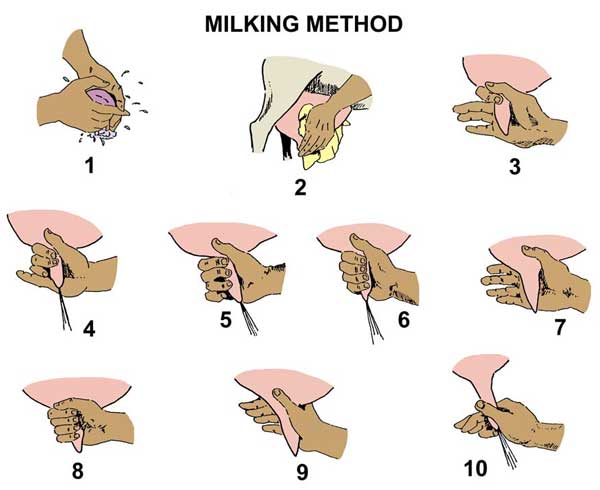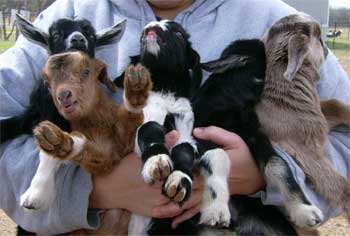The Dairy Goat — A Gallon of Milk a Day
Looking for a way to combine sufficiency with efficiency? The most efficient animal on the place is the goat. It is scoffed at by skeptics, eyed by the curious, and well-loved by those who know. Countless people already know the benefits of goat milk, but in case you haven’t heard, the milk from goats contains considerable smaller fat globules, making it easier to digest than milk from a cow. The curd is much softer and smaller, and vitamin A appears in pure form, as contrasted with carotene found in cow’s milk.
 Adults and infants alike who suffer from allergies, constipation, stomach ailments, and forms of diarrhea can successfully tolerate goat milk. It is wholesome and sweet flavored, and many people use it for making their own butter (a cream separator is needed), cheese, yogurt, ice cream, cottage cheese, and buttermilk. The doe is a clean, odorless animal, and when handled properly, her milk has a lower bacteria count than cow milk.
Adults and infants alike who suffer from allergies, constipation, stomach ailments, and forms of diarrhea can successfully tolerate goat milk. It is wholesome and sweet flavored, and many people use it for making their own butter (a cream separator is needed), cheese, yogurt, ice cream, cottage cheese, and buttermilk. The doe is a clean, odorless animal, and when handled properly, her milk has a lower bacteria count than cow milk.
Few people can use all the milk produced by a cow. On the other hand, a good milk goat can produce approximately a gallon of milk a day for most of her lactation. I say approximately, because she will take several weeks to reach her peak, and will then produce for roughly 200 days, or until she is dried off before kidding again. Keeping two does is desirable—not only do they keep each other company, but you can time the breeding so that one is in production while the other is dry. Not all does produce the expected one gallon a day, so even with two ¾ gallon milkers, there is adequate milk for the table and the feeding of young kids. When cost is compared, the goat is easily maintained on only one-sixth the amount of feed required to keep a cow, yet she produces one-fourth the amount of milk that a cow does. You can keep six goats for the cost of keeping one cow, and you’ll get more milk.
Dairy goats come in six different breeds:
- Nubians are probably the most popular; they’re easily recognized by their pendulous ears.
- French Alpines are recognizable by their contrasting black or gray markings on white, or black and brown bodies with light colored legs.
- Toggenburgs are always some shade of brown with light or white stripes on the face.
- Saanens are white or cream colored and are known as the heaviest producers.
- LaManchas have little or no ears.
- African Pygmies are a knee-high breed that not only produce milk well, but also bear kids in sets of triplets and quadruplets as often as twins.
Breeders of purebred goats are found all over the country and are happy to educate the novice. However, if you are looking to purchase a purebred, be prepared to pay a price in three digits. Ask the seller to let you see the goat’s production records and records of the goat’s ancestry. If you are not prepared to purchase top of the line, talk to a breeder about buying a grade doe. This is an unregistered doe with many of the attributes of registered stock.
Feeding
 Feeding a dairy goat can be as complex or as simple as you make it: complex if you want to raise all your own grains and hay and make your own organic ration; simple if you purchase manufactured rations. Don’t, however, make the mistake of thinking that your goat can subsist on brush or weeds and still produce milk suitable for the table. Feed her as a dairy animal.
Feeding a dairy goat can be as complex or as simple as you make it: complex if you want to raise all your own grains and hay and make your own organic ration; simple if you purchase manufactured rations. Don’t, however, make the mistake of thinking that your goat can subsist on brush or weeds and still produce milk suitable for the table. Feed her as a dairy animal.
The dairy goat is a ruminant and requires a high-fiber ration that is also high in protein. Select a ration of at least 16% protein to keep her in good health and peak production. Additional calcium is necessary, as are trace minerals. We have always fed alfalfa hay in combination with a sweet grain mixture containing can molasses. Molasses is a source of iron and other important minerals; it is commonly used in pre-mixed feeds as a binder. The alfalfa supplies needed roughage, as well as protein, calcium, and minerals, and is considered to be one of the ideal types of hay for dairy animals. Clover is another ideal hay.
Other hays are also valued, but they have less protein and calcium, so they must be supplemented with a feed concentrate or quality grain ration. These hays include barley, birdsfoot trefoil, Bermuda grass, lespedeza, marsh or prairie grasses, oat or wheat grasses, soybeans, or any combination of these. It requires about 2,000 pounds of hay per year for each mature animal, if pasture is also available.
And it takes only one acre of good, productive land to provide pasture for four producing dairy goats.
Being very clean animals, goats will not eat soiled feed. If by chance a young goat has jumped into the feed bin or manger and soiled it, other goats will refuse to eat. Therefore, keep all hay off the ground and clean the manger frequently.
Construct it in such a manner that the goats cannot climb into the hay. During very cold weather, they may not drink enough water to keep production up. The offering of warm water once or twice a day is greatly appreciated by your stock. And should a doe go off her feed and refuse to eat or drink at all, a little molasses added to the warm water is an ideal tonic.
Most of us do not have the available acreage or farm machinery needed to grow all our own feed for livestock, but we can plant the garden or harvest from nature with the dairy goat in mind. To “grow milk” in the garden, simply plant choices that will complement
your doe’s nutritional needs; they are not so different from your own. Plant sunflowers (goats enjoy both the seeds and the whole plant), mangel beets, Jerusalem artichokes, pumpkins, comfrey, carrots, kale, and sweet corn for the husks and stalks.
Gather dandelion greens, which are rich in Vitamin A, and nettles, which are high in Vitamins A and C. Bear in mind that these are only fed as treats, or in addition to the grain and hay requirements for production. Since the amount of minerals and protein in such additives are unknown, due to differences in soil types, too many garden greens and wild herbs can unbalance your dairy goat’s ration.
Avoid poisonous weeds such as milkweed, locoweed, and bracken, wild cherry after it has wilted, and certain plants that are poisonous during
certain stages of growth or after a frost. Contact your local extension agent for more complete information on feeding dairy goats or sheep, as the requirements are similar. Your agent can also give you information about poisonous plants in your area.
Equipment
Heating the barn is not necessary, but it should be draft-free and well ventilated, with plenty of bedding straw. It should also have a separate area for milking and an adjoining pasture, so the goats are free to come and go. Dairy goats are closer to the ground than cows, so for the comfort of the milker, the doe should be placed on a milking stand. You can construct one from 2x4s and plywood. (Figure 1) An udder wash solution is used to clean the udder before milking.
A pair of hoof clippers or small pruning shears is needed to keep the hooves trimmed short. Many a goat has become crippled for lack of trimmed hooves. The hooves continue to grow and, unless shortened, will curl under. When walking becomes too painful, the goat will go down on her knees and stay there.
A pair of electric clippers will keep the belly hair cut short, and also hair on the udder. This makes for a cleaner goat and cleaner milk. In summer, she can be clipped over her entire body to quickly get rid of long winter hair.
Milking
Milking should be done at the same time every day. The grain ration is fed while the doe is being fed, and not at any other time. The expense of equipment needed for milking depends on whether you intend to sell the milk commercially or only want to produce for home use. Naturally, for commercial use, you should invest in a stainless steel strainer and milk pails. For home use, plastic is satisfactory, if it is kept sanitized and used only for milking. All equipment must be scrupulously cleaned and sanitized after each milking. Do not use iron, copper, brass, or chipped equipment when handling milk, as they cause the milk to oxidize, which affects the flavor. Immediately after milking, strain the milk through a milk strainer containing a disposable filter. A double thickness of cheesecloth can also be used if it is washed and sanitized in bleach after each use. (This is not recommended for other than home use.) Using a clean, sanitized funnel, pour the milk into glass containers and apply lids. My favorite containers are Gatorade bottles. They hold about a quart and have long necks for easy handling. Quart-size or half-gallon canning jars can also be used, but I find them more difficult to pour from than Gatorade bottles. Always wash and sterilize the containers after each use, so they are ready for the next filling. Refrigerate the milk immediately.

Pasteurization
Home pasteurization is also possible with very little extra work. You can buy a small pasteurizer or invest in a cooking thermometer. Pasteurization is not sterilization; it is merely a heat treatment to kill disease-producing bacteria and reduce the number of other micro-organisms. It destroys harmful bacteria which may have entered the milk through handling. It also destroys the enzyme lipase, which reacts with butterfat in milk causing it to become rancid and develop a goaty flavor. Fresh goat milk should taste no different from fresh cow milk.
Also, you, as a handler, can be a carrier of harmful bacteria without realizing it. Farms with outdoor toilets are suspect for deadly organisms that cause septic sore throat, scarlet fever, dysentery, Q-fever, gastroenteritis, diptheria, paratyphoid, and typhoid fever. Many infants are fed farm-bought goat milk, and it’s very important to make sure that all milk that leaves the premises is safe.
Pasteurizing in the bottle: Place the milk in a bottle that has a cover with a hole punched in it large enough to receive the thermometer. Place the bottle of milk on a rack in a deep pan or pail. A large canner is ideal for this method if you are processing more than one or two bottles. Add warm water to the pan or canner until the water level reaches the level of the milk in the bottle. Place over heat and warm until the thermometer in the bottle reads 145 degrees. Remove from heat and leave the bottle in the hot water for 30 minutes. Continue checking the temperature of the milk; if it drops below 145 degrees, reheat slightly. This temperature must be maintained for a full 30 minutes. After 30 minutes, gradually replace the hot water with cold water, until the milk has cooled. After the milk cools, keep it cold by refrigeration.
Pasteurizing by double boiler: Pour the milk into the top of a double boiler and insert the thermometer. Heat over hot water until the thermometer registers 165 degrees, stirring constantly. When the milk reaches 165 degrees, maintain that temperature for 20 seconds, then remove and cool immediately by plunging it into cold water. Change the water frequently, or add ice to cool the milk. Continue to stir the milk until it’s cold. Pour the milk into sterilized containers, cover, and refrigerate. Do not over-process, or a cooked flavor will develop.
Batch-type pasteurization: This method is used with an electric batchtype home pasteurizer. It will pasteurize
two gallons of milk or more, or as little as two quarts. These appliances are almost automatic and don’t take much of your time or attention. Follow the directions provided by the manufacturer of your particular unit.
Breeding and kidding
To keep the doe in high production, not only must she be fed a highly nutritious ration, she should be bred each year. Some does are known to produce young twice in a year. Kidding usually occurs in the spring, after a gestation period of 150 days, or roughly 5 months.
If you don’t have your own buck, notify the breeder who sold you the doe and make arrangements for breeding far in advance. This is necessary because the doe will be receptive for only 24 hours (or less), so you must be ready to transport her to the buck on short notice. To check the doe for receptiveness, place your hand on her back and stroke her down to the base of her tail. If she ignores this gesture or tucks her tail against her body, she is not ready to be serviced. If she wags her tail excitedly, it’s time to breed her. This back stroking is the simplest method for detecting heat. Other signs to watch for are redness or a swelling under the tail, a slight discharge, bleating and restlessness.
 Each kidding season is a new experience of baby goats and bottles and nipples. Twins are usual, but it’s not uncommon to have triplets. When each kid arrives, clean the mouth and nose of membrane and mucus. Cut the umbilical cord and dip the end into a small jar of iodine. We always take the newborn from the mother immediately after allowing it to stand and nurse for a few minutes. This way the mother can be hand-milked twice a day and the surplus milk used on the table. Otherwise, she will produce only enough for her kids. The first feeding is most important, as the kids receive antibodies through the colostrum. The colostrum also works as a laxative to start the immature digestive system working.
Each kidding season is a new experience of baby goats and bottles and nipples. Twins are usual, but it’s not uncommon to have triplets. When each kid arrives, clean the mouth and nose of membrane and mucus. Cut the umbilical cord and dip the end into a small jar of iodine. We always take the newborn from the mother immediately after allowing it to stand and nurse for a few minutes. This way the mother can be hand-milked twice a day and the surplus milk used on the table. Otherwise, she will produce only enough for her kids. The first feeding is most important, as the kids receive antibodies through the colostrum. The colostrum also works as a laxative to start the immature digestive system working.
Colostrum is the thick, yellow substance produced by the doe for the first few days after giving birth. It is wonderful for feeding all sorts of orphans on the farm, and I always keep a pint or more of it in my freezer to save newborn puppies and kittens as well as lambs, pigs, calves, and just about any young thing that needs bottle feeding.
The newborn kids are brought into the house and placed in a box filled with straw. From that point until they are weaned, they are fed from a sixteen-ounce pop bottle with a lamb’s nipple attached. At first, they take only two or three ounces every four hours, but as they grow they are soon taking sixteen ounces of milk three times a day and experimenting with grass and grain.
Young goats are clowns. They leap and pirouette as gracefully as any ballet dancer. They love attention but can become a nuisance if allowed to run free. Add to this the fact that they are notorious escape artists and you could have your hands full keeping them out of trouble. Fencing should be of suitable height to prevent them from jumping over, closely woven to prevent stepping through, and made of a safe material to prevent injuries. Barbed wire should never be used to confine goats. Although you may be tempted to step over a low enclosure yourself, don’t do it! Climbing or stepping over a fence is a sure-fire way to teach young rascals that a fence can be jumped. Always use the gate and young goats will learn the only way in or out is through that gate.
Because they are filled with energy and curiosity, young goats appreciate a few objects of amusement to satisfy their desire to climb, leap, and perform gymnastics. A platform, a barrel, a couple of old tires stacked one on the other—and they’ll never be bored. A tire suspended from a tree makes an excellent opponent in mock combat for an adult buck. A mature doe with an udder is less likely to indulge in such nonsense, but don’t let that fool you. They may be less likely to jump a fence, but they are unusually canny about going under.
The young bucks are castrated at an early age and used in the woodlot to clear brush; they can also be sold or eaten. The meat is known as chevon and is delicious barbecued. The hide is tanned and made into leather goods. No other farm animal offers such amusement and affection, clears a woodlot, produces fertilizer in convenient pellet form, and places meat, cheese, and milk on the table. So much for so little— naturally.
Additional Research:
   |